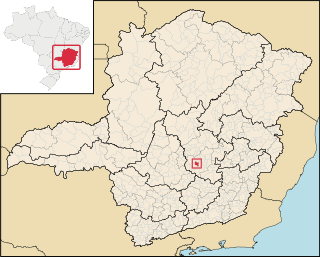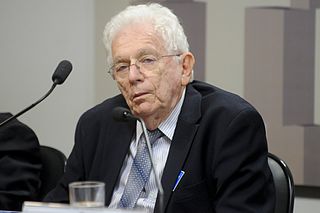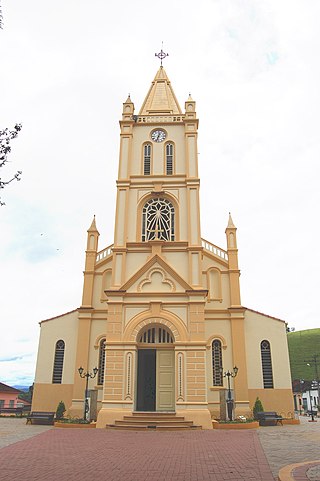
Belo Horizonte is the sixth-largest city in Brazil, with a population of around 2.7 million, and the third largest metropolitan area, with a population of 6 million. It is the 13th-largest city in South America and the 18th-largest in the Americas. The metropolis is anchor to the Belo Horizonte metropolitan area, ranked as the third most populous metropolitan area in Brazil and the 17th most populous in the Americas. Belo Horizonte is the capital of the state of Minas Gerais, Brazil's second-most populous state. It is the first planned modern city in Brazil.

Minas Gerais ( ) is a state in Southeastern Brazil. It ranks as the second most populous, the third by gross domestic product (GDP), and the fourth largest by area in the country. The state's capital and largest city, Belo Horizonte, is a major urban and finance center in Latin America, and the sixth largest municipality in Brazil and its metropolitan area is the third largest in Brazil with just over 5.8 million inhabitants, after those of São Paulo and Rio de Janeiro. Nine Brazilian presidents were born in Minas Gerais, the most of any state. The state has 10.1% of the Brazilian population and is responsible for 8.7% of the Brazilian GDP.

The Federal University of Minas Gerais is a federal research university located in the state of Minas Gerais. Its main and biggest campus is located in the city of Belo Horizonte, Brazil. It is one of Brazil's five largest and highest-ranked universities, being the largest federal university. It offers 79 undergraduate education programs, upon completion of their curricular schedule the student is awarded either a bachelor's degree, a licenciate degree, or a professional title, all officialized by the issue of a university diploma. It also has 90 postgraduate education programs, awarding 30 postbaccalaureate specialization degrees, 92 master's degrees, and 72 doctoral degrees, as well as 41 medical residency programs offered at UFMG's hospital facilities complexes.

Contagem is a city in the center of the state of Minas Gerais, in Brazil. It is only 21 kilometres from the capital, Belo Horizonte, and forms part of a metropolitan area with a population of 4.8 million.

Montes Claros is a city located in northern Minas Gerais state, in Brazil. It is located north of the state capital, about 422 km away from it. The population is 413,487 in an area of 3,569 km2 (1,378 sq mi). It was made a seat of a municipality in 1831 and attained city status in 1857.

Diamantina is a Brazilian municipality in the state of Minas Gerais. Its estimated population in 2020 was 47,825 in a total area of 3,870 km2.

Viçosa is a Brazilian municipality in the state of Minas Gerais. Its population as of 2021 was estimated at 79,910 inhabitants.

Três Pontas is a municipality located in southern Minas Gerais state, Brazil. It's a city with about all streets of urban zone paved and services of water and sewage to all people. The municipality has about 57 thousand inhabitants and a population density of 78,12hab/km2. The road MG-167 is the only paved road that passes through the city, but the Rodovia Fernão Dias (BR-381), is less than 50 km from the city centre passing through Varginha.

Mineiro, Mineirês, or the Brazilian mountain accent is the Brazilian Portuguese term for the accent spoken in the Center, East and Southeast regions of the state of Minas Gerais.

The University of Brasília is a federal public university in Brasília, the capital of Brazil. It was founded in 1960 and has since consistently been named among the top five Brazilian universities and the top fifteen universities in South America by Times Higher Education (THE).

Lavras is a municipality in southern Minas Gerais state, Brazil. Located at an altitude of 919 m, it has a population of 104,761 inhabitants (2022). The area of the municipality is 564.495 km2. The average annual temperature is 19.6°C and the average annual rainfall is 1,511 millimetres.

Betim is a town in Minas Gerais, Brazil. The city belongs to the mesoregion Metropolitan of Belo Horizonte (BH) and to the microregion of Belo Horizonte. It is the fifth largest city in Minas Gerais and one of the 50 largest cities in the Southeast of Brazil.

Ibirité is a Brazilian municipality located in the state of Minas Gerais. The city belongs to the mesoregion Metropolitana de Belo Horizonte and to the microregion of Belo Horizonte. Its population in 2020 was 182,153.

Simon Schwartzman is a Brazilian social scientist. He has published extensively, with many books, book chapters and academic articles in the areas of comparative politics, sociology of science, social policy, and education, with emphasis on Brazil and Latin America. He was the President of the Brazilian Institute for Geography and Statistics (IBGE) and is a retired professor from the Federal University of Minas Gerais. He is member of the Brazilian Academy of Sciences, holder of the Grand Cross of the Brazilian Order of Scientific Merit (1996). He is currently associate researcher at the Institute for Studies in Economic Policy Instituto de Estudos de Política Econômica / Casa das Garças - Rio de Janeiro.
Access to at least basic water increased from 94% to 97% between 2000 and 2015; an increase in access to at least basic sanitation from 73% to 86% in the same period;
The Pontifical Catholic University of Minas Gerais is a private and non-profit Brazilian Catholic university in Belo Horizonte, state of Minas Gerais. In 2006, 2010, 2011, 2013 and 2014, PUC-MG was chosen the best private university in Brazil. It is maintained by the Catholic Archdiocese of Belo Horizonte.

Piranguinho is a municipality in the state of Minas Gerais in the Southeast region of Brazil.

The Federal University of Triângulo Mineiro is a public university located in the city of Uberaba, Minas Gerais, Brazil, formerly FMTM and transformed into a university in 2005 by a federal government decree.

The Catholic University Center of Eastern Minas Gerais (Unileste) is a Brazilian private higher education institution based in Coronel Fabriciano, in the interior of the state of Minas Gerais. It was created as part of the social works of the Padres do Trabalho Congregation in 1969, configuring itself as the first technical and higher education level school in the current Steel Valley Metropolitan Region (RMVA).

Betim Futebol is a Brazilian professional club based in Betim, Minas Gerais, founded in 2019. It competes in the Campeonato Mineiro Módulo II, the second division of the Minas Gerais state football league.
















